An excellently finished basement is no doubt an asset to a home. So, whether you plan to use it as a home office, family room, guest suite, or entertainment area, it is crucial to prioritize waterproofing. Waterproofing a basement goes beyond aesthetics; it ensures a dry and healthy environment, protects your investment, and safeguards the structural integrity of your building.
The Risk of an Unprotected Finished Basement
An unprotected finished basement is susceptible to various water-related hazards that can cause significant damage and compromise the livability of the space. Let’s explore some of the risks:
- Water Intrusion: Moisture can find its way through cracks in the foundation walls or floors. This water intrusion leads to dampness, musty doors, and the growth of mold and mildew. These can affect the basement and pose a health risk to the occupants of the home.
- Flooding: Heavy rainstorms or plumbing failures can lead to basement flooding. This damages your belongings and causes structural damages, electrical hazards, and potential contamination if sewage backup occurs. Dealing with the aftermath of flooding can be expensive and time-consuming.
- Damages to Finishes: Water can damage the finishing of a building, including drywall insulation, flooring, and even furniture. This can result in costly repairs and the need to replace materials, affecting the space’s aesthetics and functionality.
- Structural Integrity: The foundation is the heart and soul of a building. A building cannot stand the test of time without a good foundation. Excessive moisturein the basement can weaken the foundation and compromise the structural integrity of the building. Over time, this can lead to foundation cracks, shifting walls, and other structural issues that require extensive and costly repairs.
Effective Waterproofing Solutions
To ensure a dry and healthy living space in your finished basement, consider implementing the following waterproofing solutions:
- Exterior Waterproofing: This method involves excavating around the foundation and applying a waterproof barrier to the external walls. Doing this creates a protective layer that prevents water from penetrating the foundation. Exterior waterproofing also includes proper grading to ensure water flows away from the basement walls and installing effective drainage systems, such as French drains, to redirect water away from the foundation.
- Interior Waterproofing: The technique used is applied from inside the basement. This includes installing a waterproof membrane sealant on the interior walls, using specialized paints, and implementing effective drainage systems such as sump pumps. Interior waterproofing methods help manage water penetrating the exterior barrier and direct it away from the living space.
- Proper Drainage: Adequate waterproofing is essential for basement waterproofing. Ensure that your gutter downspouts extend away from the foundation, directing water at least five to ten feet away. Also, ensure that the grading of your home slopes away from the basement walls to prevent water accumulation near the foundation.
- Sump Pump Systems: A sump pump is a crucial component of basement waterproofing, especially in areas prone to flooding or with a high water table. It collects water that enters the basement through the foundation drain or internal drainage systems and pumps it away from the basement, preventing flooding and water damage.
- Vapor Barriers: Installing a vapor barrier, such as a waterproof membrane or specialized paint, on the interior basement walls can help prevent moisture infiltration and condensation. Vapor barriers act as a protective layer, preventing moisture from entering the living space and reducing the risk of mold and mildew growth.
Consulting Professionals
Some homeowners may opt for DIY waterproofing. However, consulting professionals is highly recommended. Waterproofing experts are experienced and equipped to assess your situation, provide the best solutions, and ensure proper installation. They can also address any underlying issues, such as foundation cracks or inadequate drainage, that may contribute to water problems. Investing in professional assistance ensures that the waterproofing process is done correctly, minimizing the risks of future water damage, and ensuring a long-lasting solution.
Maintenance and Regular Inspections
Once your finished basement is waterproofed, regular maintenance and inspections are crucial to preserving its integrity. Look for signs of water intrusion, such as dampness, musty odors, or water stains on walls or floors. Promptly address any issues; even minor leaks can escalate into significant problems if left unattended. Regularly inspect and test your sump pump system to ensure it functions correctly and clear any debris that may impede its operation. Additionally, ensure that gutters and downspouts remain free from clogs and effectively direct water away from the foundation.
Conclusion
Waterproofing a finished basement is vital in ensuring a dry, healthy, and comfortable living space. Homeowners can avoid costly repairs by preventing water intrusion with waterproofing solutions, providing a functional and enjoyable basement space. Remember to consult professionals, prioritize regular maintenance and inspections, and create a safe and habitable environment for you and your family. With an adequately waterproofed finished basement, you can confidently enjoy the additional living space while preserving the value and integrity of your home for years to come.


